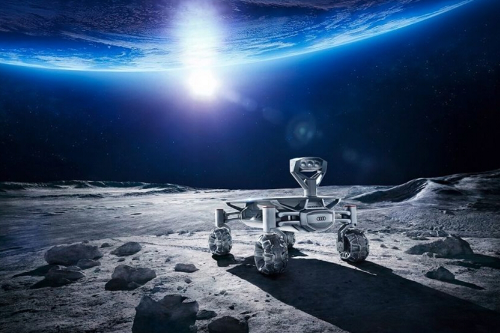Lunar History: How Do You Solve a Problem Like Maria?
月球的历史:如何解决月海这样的问题?
An ancient collision may explain the moon’s Janus faces
一次古老的碰撞可能解释月球的杰纳斯面孔
Earth’s moon has a split personality. One half of its surface – the half which, thanks to the vagaries of orbital mechanics, always faces Earth – is dominated by dark, smooth expanses of ancient, frozen lava known as maria (early astronomers, thinking they might be bodies of water, named them after the Latin word for “sea”). The contrast between the darkness of the maria and the brightness of the surrounding highlands forms a pattern popularly known, depending on the culture of the observer, as the man in the moon, the rabbit on the moon or one of many other optical illusions.
地球的卫星——月球有着分裂的人格。其表面的一半——由于轨道力学的变幻莫测,这一半总是面对地球——一直处于黑暗之中。这片黑暗的地方被称为月海,不仅平坦广阔,而且由古老而冻结的火山岩形成(早期的天文学家认为这片地域可能为水体,因而以拉丁词“海”命名)。根据观察者不同的文化,月海的黑暗和周围群山的明亮对比形成了一种众所周知的模式,比如嫦娥,月兔或许多其它视错觉之一。
When astronomers got their first glimpses of the moon’s far side, however, they saw a strikingly different landscape. Early lunar probes revealed a surface that was mountainous, rugged, heavily cratered and virtually devoid of maria. To quote Bill Anders, one of the astronauts on Apollo 8 and thus one of the first three people to see the far side of the moon directly, it “looks like a sand pile my kids have been playing in... all beat up, no definition, just a lot of bumps and holes.”
然而,当天文学家首次瞥见月球较远的那侧时,他们看到了一处截然不同的景观。早期月球探测器显示了这块多山,崎岖不平,拥有大量陨石坑以及几乎毫无大海的地域的表面。引用阿波罗8号宇航员之一,也是首次直接看到月球较远那侧的三个人之一的比尔·安德斯的话说,那块地方“就像孩子们玩的沙堆一样……到处都是破破烂烂的,无法解释,就是很多坑坑洼洼。”
Selenologists, as those who study the moon call themselves, have kicked around many theories to explain the differences between the moon’s two faces: Earth partly shielding the moon from meteoritic impacts; uneven heating from beneath; the collision that excavated a 2,500km-wide crater at the lunar south pole, one of the biggest in the solar system. None seems satisfactory. But in a paper just published in Nature Martin Jutzi and Erik Asphaug of the University of California, Santa Cruz, examine yet another idea. This is that the mountains of the lunar far side may be debris left over from an even bigger collision than the one at the south pole – a collision that left lumps on the lunar surface rather than digging holes in it.
作为研究月球而称他们自己为月球学家的那些人已经非正式地讨论了许多理论来解释月球的两种截然不同表面的区别:地球部分地保护了月球免受陨石的碰撞;月球内部不均匀的加热;在月球南极空砸出一个2500公里宽的陨石坑——太阳系最大的陨石坑之一——的那次碰撞。好像没人对些理论满意。但是,加州大学圣克鲁斯分校的马丁·彻奇希(Martin Jutzi)和埃里克·阿萨福格(Erik Asphaug)刚刚在《自然杂志》发表的一篇论文检验了迄今为止的另一个猜想。这个猜想就是月球较远那侧的群山甚至可能是比月球南极那次碰撞更大的碰撞所留下的岩屑——这次更大碰撞在月球表面留下了隆起,而非砸坑。

Moonstruck
沉迷于幻想
The most widely accepted theory of how the moon formed suggests it is the result of a cosmic smash-up between Earth and an object roughly the size of Mars that happened about 4.5 billion years ago during the solar system’s turbulent youth. This impact would have sprayed huge quantities of material into space, forming a ring around Earth similar to, but much thicker than, those that now adorn Saturn.
月球如何形成的最广泛接受的理论表明,大约发生在45亿年前的年轻的太阳系动荡期间,地球和一个大约火星大小的物体间的宇宙大碰撞的结果而产生了月球。这次碰撞已将大量的物质散发到了太空,从而形成了环绕地球的光环,类似于那些现在装饰土星的光环,但是要厚得多。
The moon is thought to have condensed rapidly from this ring. Computer simulation of the process suggests, however, that several smaller moons may have formed at the same time. Some would then have collided with Earth or the moon, while others would have been ejected from the system altogether. But one or more of them often end up, according to the simulations, in what are known as Trojan orbits, where they followed the proto-moon endlessly around Earth.
月球被认为是从这个光环的气体凝聚而成。然而,计算机模拟的过程表明,这次大碰撞可能在同一时间形成了几个更小的卫星。然后,有些卫星就与地球或月球相撞,而其它卫星则完全被太阳系喷射出来。但,根据计算机多次模拟,其中的一个或多个卫星往往停留在被称为特洛伊星座的轨道上而终结。这些卫星在那儿伴随着永无休止地围绕地球的原月。
Or, rather, almost endlessly. For the hypothesis of Dr Jutzi and Dr Asphaug is that a large moonlet did eventually catch up and collide with the proto-moon – at a relatively low speed given that they shared an orbit – and produced the highlands on its far side as a result.
或者,更确切些,几乎是没有休止的。因为彻奇希博士(Dr Jutzi)和阿萨福格博士(Dr Asphaug)的假说就是一个大的小卫星最终赶了上来并与这个原月发生了碰撞——考虑到它们共享一条轨道,是以相对低的速度碰撞——结果,就在月球较远的那侧产生了那些群山。
To test their theory, the two researchers simulated such a collision on a computer. They found that, assuming the second moon was indeed smaller than the main one, and was made of similar stuff (which, given that it is assumed to have formed from the same ring of debris, seems reasonable), then a comparatively low-speed collision at around 2.4 kilometres a second would mean that much more material from the moonlet was deposited on the lunar surface than was blasted off by the impact. Most of the excess rock, moreover, would have stayed near the point of impact, covering about half of the moon with a thicker, mountainous layer of crust – just what is seen on the real moon.
为了测试他们的理论,这两位研究者在计算机上模拟了这样一次大碰撞。他们发现,假设第二个月球确实比最大的月球(指的是原月)要小,并且由相似的物质组成(考虑到这个月球是从岩屑的同样光环形成的,说它们为相似的物质好像也有道理)。然后,以大约每秒2.4公里的相对低速碰撞意味着,小卫星上更多的物质被沉积在月球表面而不是因碰撞而喷射出来。此外,过多的岩石将留落在碰撞点附近,且以更厚、多山的外壳层占了月球约为一半的面积——正如真正月球上所见到的一样。
Of course, computer simulations can say only what could have happened, not what did. For that, physical evidence is required. Some suggestive evidence does exist, though. For a start, the crust on the far side of the moon is indeed much thicker than that on the nearside. Also, because the second moon would have been smaller than the main one, it would have cooled and solidified more quickly, meaning that its rocks would be older. Sure enough, different parts of the present moon’s crust, recovered by various missions to the lunar surface, differ in age by up to 200m years, a fact that has long puzzled selenologists but which the impact theory neatly explains. Moreover, such a huge collision on the far side would have shifted much of the magma ocean that then underlay the moon’s surface to the near side, which led to the formation of the maria.
当然,计算机模拟只能估计已经发生的情形,而不是确实发生的情况。为此,实物证据是需要的。虽然,某些提示性的证据确实存在。因为从一开始,较远那侧的月球外壳确实比较近侧的外壳要厚实的多。此外,因为这第二个月球应该比最大的月球要小的多,所以这个月球应该冷却、凝固要快得多。这也意味着这个月球的岩石要年久的多。果真如此,现在月球外壳的不同部分,各次去月球表面的探测任务发现,这些岩石年代的不同达到2亿年之久。一个长期困扰月球学家的客观事实被碰撞理论巧妙地解释了。此外,在月球较远那侧如此巨大的一次碰撞应该迅速移动很多岩浆洋,然后在月球表面一直铺到近地侧,这就导致了月海的形成。
More evidence may surface when the Gravity Recovery and Interior Laboratory mission, an American spacecraft designed to map the moon’s gravitational field, arrives in lunar orbit in around six months’ time. That should yield a detailed map of the lunar crust, and how its thickness varies from place to place. But the best way to check the new hypothesis would be for selenologists to get their hands on rocks from the far side.
当引力恢复和室内实验任务时,更多的证据可能会出现。一架设计用来勘测月球引力场的美国航天器,大约会在六个月内到达月球轨道。这次探测任务应该会产生出一份详细的月球外壳图,以及各个地方的厚度如何变化。但是,对月球学家来说,检查这个新假说的最好方式就是找到月球较远那侧的岩石。
Sadly, that is unlikely to happen soon. Neither America nor Russia has any sample-recovery missions planned for the moon. China does. But, like the American and Soviet missions of the 1960s and 1970s, the Chinese are expected to opt for the safety of a landing on the near side. Selenologists may therefore have to wait a long time before they can test the Jutzi-Asphaug model properly.
可叹的是,这种情况不可能很快发生。无论是美国还是俄罗斯都没有任何计划去月球恢复取样的任务。中国倒有一个。但是,像20世纪60年代和70年代的美国和苏联的任务一样,中国人选择在近地侧安全着陆。因此,月球学家可能需要等待很长一段时间才能够真正测试彻奇希-阿萨福格模型。
英文、中文版本下载:http://www.yingyushijie.com/shop/source/detail/id/753.html








